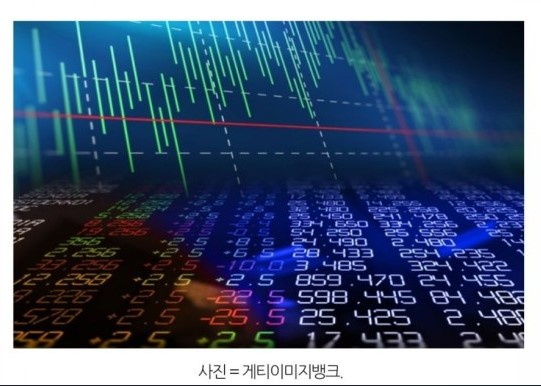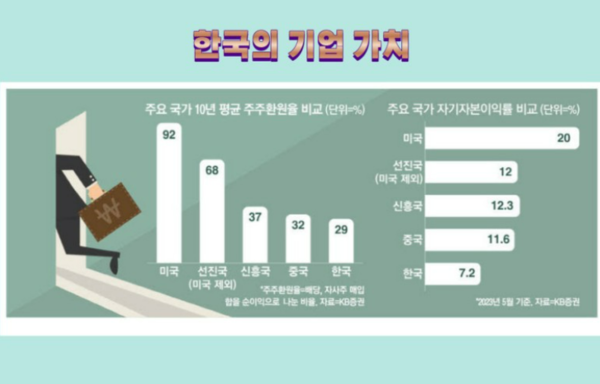In 1880, the corporation system was introduced to Korea for the first time by enlightenment figures. They claimed that Korea should develop by establishing corporations to build railways, ships, and land improvement companies. They explained how to recruit and buy stocks, and as a result, many corporations started to be established in Korea. Since the founding of corporations, shareholders who have been buying and selling stocks have desired an exchange where they could trade their shares safely. This is why the first exchange was created.
The Korean stock market, which emerged from the historical background described above, is assessed by individual and institutional investors both domestically and abroad as having not yet achieved "economic democratization." Several reasons support this assessment.

The first issue revolves around a right commonly referred to as 'ownership'. Their share typically ranges from 20 to 30 percent. However, the influence they wield over businesses is disproportionately significant. Secondly, when compared to other developed and developing countries such as the United States, Japan, and China, the shareholder return rate (ROE) of Korean companies ranks the lowest. The U.S. boasts a rate of 92%, China 32%, and advanced countries 68%, whereas Korea's stands at 29%, even lower than China's. Additionally, the Price-to-Book Ratio (PBR) in the Korean stock market remains below 1. This indicates that Korean companies are undervalued in comparison to their actual asset value. Consequently, Korean companies might receive more funds if they were to close and liquidate their businesses rather than continue operations. This undervaluation of the Korean stock market is referred to as a “Korea Discount”.
One example illustrating the occurrence of the Korea Discount is the physical division system, commonly referred to as 'split listing'. Initially, this division system was introduced to facilitate companies in restructuring after the IMF financial crisis. It aimed to swiftly organize non-beneficial business units within companies. Essentially, it was designed to assist businesses. However, contrary to its intended purpose, the system is now being exploited to maximize owners' profits by divesting the company of its net business units.
The second reason contributing to the Korea Discount is the disparity between the holding company structures of Korean listed companies and those of companies in advanced countries. To illustrate this point, let's examine the structure of Alphabet, Google's parent company. Alphabet, as the holding company, owns several subsidiaries including Google X and Google Ventures, alongside the well-known Google itself. Alphabet holds 100% ownership of these subsidiaries, meaning their operating performance is reflected in Alphabet's overall performance. Consequently, shareholders can exert influence over all subsidiaries proportional to their own shares.
Contrastingly, let's consider LG's holding company structure in Korea. LG initially divided LG Chemical into LG Chemical and LG Health Care, and LG Electronics into LGEI and LG Electronics. Despite being a holding company, LG itself remains listed, while all its subsidiaries are also listed independently. This structure poses a challenge as it complicates the evaluation of the Korean stock market objectively, ultimately resulting in an overall undervaluation of the stock market.

On February 26, 2024, the government announced a policy known as the "Value-Up Program" aimed at addressing the Korea discount resulting from the aforementioned reasons. As highlighted earlier, Korea's shareholder return rate (ROE) ranks as the world's lowest. In response, the government introduced tax support measures to encourage companies to prioritize shareholder returns. First, if a company repurchases its treasury stock, it will be treated as an expense, resulting in a reduction in corporate tax. This practice of repurchasing treasury stocks decreases the company's equity capital while boosting its earnings per share. Second, if a company increases its dividends compared to the previous quarter, the government will offer tax deductions on the increased dividends. By incentivizing dividend increases, the government aims to encourage shareholders to reinvest dividends in the company, fostering a beneficial cycle between the company and its shareholders.
Furthermore, as part of the Value-Up Program policy, the government emphasized the need for companies to enhance various systems to prevent irregularities such as improper dividend procedures, material divisions, insider trading, and share buybacks. The government has stated that these measures will contribute to enhancing corporate value. Additionally, the government urged companies to take proactive steps to increase their own corporate value if the capital market is to progress further. However, it is noted as a limitation of this announcement that there are no penalties attached to these suggestions and efforts. Ultimately, criticism has been directed at the lack of government enforcement, leaving it to corporate autonomy.
Despite starting later than other advanced countries, Korea's economy experienced rapid growth and quickly reached a similar level within a short timeframe. As of 2024, Korea continues to maintain an economic growth rate that is comparable to other advanced nations. However, when focusing specifically on the stock market, the KOSPI has remained stagnant since 2020, unlike the S&P 500 and EuroStoxx indices. Failure to address this situation poses a risk of interrupting the upward trajectory of the Korean economy. It appears imperative that the government implements practical and compulsory alternatives rather than solely relying on corporate autonomy.

